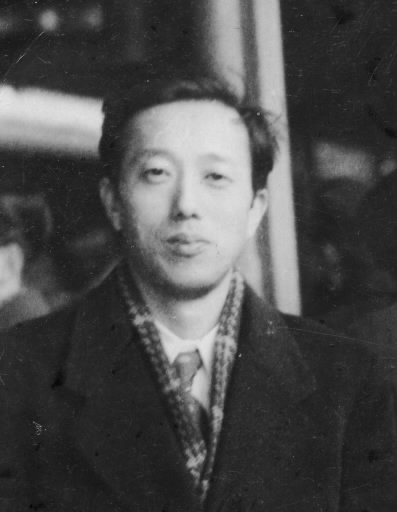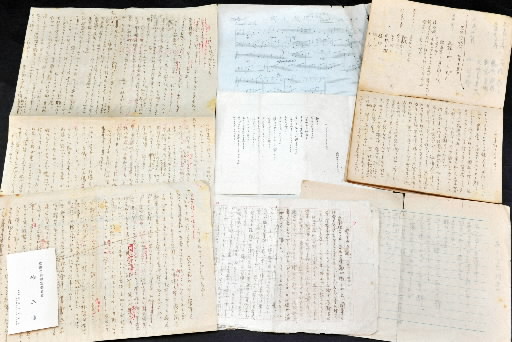Unpublished writings by Sankichi Toge, well-known A-bomb poet, are discovered
Jan. 9, 2014
by Masami Nishimoto, Senior Staff Writer
About 20 unpublished writings by Sankichi Toge (1917-1953), known for his Poems of the Atomic Bomb, have been discovered. They include the draft of a plan to reconstruct Hiroshima, produced in the year following the atomic bombing, and some poems. The Association of Preservation Data on Hiroshima Literature received these materials from Yorio Mito, Mr. Toge’s nephew, and is working to confirm their authenticity. Mr. Mito died last year at the age of 81. The document on Hiroshima’s reconstruction is apparently a rough draft of Mr. Toge’s essay entitled “Hiroshima in 1965,” which was awarded first prize in a competition conducted by the Chugoku Shimbun in 1946, soliciting ideas for the city’s revival. The association plans to entrust Hiroshima Peace Memorial Museum with the materials.
The reconstruction plan was written in a small notebook and titled “Hiroshima in 20 Years,” eyeing the future of the city in 1965.
Mr. Toge wrote: “At the hypocenter of the atomic bomb is a ‘Peace Plaza’ with a huge memorial made of steel and granite, a symbol of the tragedy.” He goes on to explain that at the base of the memorial is a room for mourning where materials evoking “the guilty nature of war itself” are displayed. In a park surrounding the plaza are a library, a museum, a music hall, an art museum, and a hall where Japanese citizens and international visitors could gather.
Places on the Hiroshima delta are linked by subway lines. The document also notes that, “ideally,” the city would incorporate facilities in every district to support people’s lives, work, recreation, and health.
Mr. Toge unveiled his view of the “ideal Hiroshima” in his essay for the competition as well. The essay was awarded the first prize among the 171 essays that were submitted, and it appeared in the Chugoku Shimbun August 2~4, 1946. But in the 1970s, those who knew Mr. Toge said that the essay had actually been composed by his elder brother. Thus, The 40-Year History of the Atomic Bombing in Hiroshima, compiled by the city, mentions the essay, but adds the suggestion that it may have been written by Mr. Toge’s brother, resulting in continuing uncertainty with regard to its authorship.
Among the newly-found materials is another draft of the essay, written on rough paper and entitled “Utopia Hiroshima City in 20 Years.” This draft, along with the draft which appears in the notebook, are valuable documents which may answer the question concerning the true author of the winning essay.
The materials also include a poem entitled “An Imagined Scenery,” on the theme of the Atomic Bomb Casualty Commission (ABCC, now the Radiation Effects Research Foundation), and a poem entitled “Christmas in 1950,” which was sent to his wife Kazuko (who died in 1965) when he was hospitalized at the National Hiroshima Sanatorium (currently, the National Hospital Organization Higashihiroshima Medical Center). Other writings, which indicate Mr. Toge’s breadth of interests, include haiku and original musical scores.
Newly-found materials corroborate prize-winning essay
Masahiko Ikeda, 67, the secretary general of the Association of Preservation Data on Hiroshima Literature, said: “Although those who wrote books on Mr. Toge have claimed that ‘Hiroshima in 1965’ was the work of Mr. Toge’s elder brother, it is reasonable to believe that the essay was written by Mr. Toge himself when this work is cross-checked with the original drafts. It may be true that his brother, who had been involved in the labor movement from the pre-war period, provided some advice, but the essential elements of the essay remain the same. Has the vision of an ideal city of peace, the dream of a 29-year-old man at that time, been realized? I hope that people will read Mr. Toge’s works to again reflect on this question.”
(Originally published on January 6, 2014)
About 20 unpublished writings by Sankichi Toge (1917-1953), known for his Poems of the Atomic Bomb, have been discovered. They include the draft of a plan to reconstruct Hiroshima, produced in the year following the atomic bombing, and some poems. The Association of Preservation Data on Hiroshima Literature received these materials from Yorio Mito, Mr. Toge’s nephew, and is working to confirm their authenticity. Mr. Mito died last year at the age of 81. The document on Hiroshima’s reconstruction is apparently a rough draft of Mr. Toge’s essay entitled “Hiroshima in 1965,” which was awarded first prize in a competition conducted by the Chugoku Shimbun in 1946, soliciting ideas for the city’s revival. The association plans to entrust Hiroshima Peace Memorial Museum with the materials.
The reconstruction plan was written in a small notebook and titled “Hiroshima in 20 Years,” eyeing the future of the city in 1965.
Mr. Toge wrote: “At the hypocenter of the atomic bomb is a ‘Peace Plaza’ with a huge memorial made of steel and granite, a symbol of the tragedy.” He goes on to explain that at the base of the memorial is a room for mourning where materials evoking “the guilty nature of war itself” are displayed. In a park surrounding the plaza are a library, a museum, a music hall, an art museum, and a hall where Japanese citizens and international visitors could gather.
Places on the Hiroshima delta are linked by subway lines. The document also notes that, “ideally,” the city would incorporate facilities in every district to support people’s lives, work, recreation, and health.
Mr. Toge unveiled his view of the “ideal Hiroshima” in his essay for the competition as well. The essay was awarded the first prize among the 171 essays that were submitted, and it appeared in the Chugoku Shimbun August 2~4, 1946. But in the 1970s, those who knew Mr. Toge said that the essay had actually been composed by his elder brother. Thus, The 40-Year History of the Atomic Bombing in Hiroshima, compiled by the city, mentions the essay, but adds the suggestion that it may have been written by Mr. Toge’s brother, resulting in continuing uncertainty with regard to its authorship.
Among the newly-found materials is another draft of the essay, written on rough paper and entitled “Utopia Hiroshima City in 20 Years.” This draft, along with the draft which appears in the notebook, are valuable documents which may answer the question concerning the true author of the winning essay.
The materials also include a poem entitled “An Imagined Scenery,” on the theme of the Atomic Bomb Casualty Commission (ABCC, now the Radiation Effects Research Foundation), and a poem entitled “Christmas in 1950,” which was sent to his wife Kazuko (who died in 1965) when he was hospitalized at the National Hiroshima Sanatorium (currently, the National Hospital Organization Higashihiroshima Medical Center). Other writings, which indicate Mr. Toge’s breadth of interests, include haiku and original musical scores.
Newly-found materials corroborate prize-winning essay
Masahiko Ikeda, 67, the secretary general of the Association of Preservation Data on Hiroshima Literature, said: “Although those who wrote books on Mr. Toge have claimed that ‘Hiroshima in 1965’ was the work of Mr. Toge’s elder brother, it is reasonable to believe that the essay was written by Mr. Toge himself when this work is cross-checked with the original drafts. It may be true that his brother, who had been involved in the labor movement from the pre-war period, provided some advice, but the essential elements of the essay remain the same. Has the vision of an ideal city of peace, the dream of a 29-year-old man at that time, been realized? I hope that people will read Mr. Toge’s works to again reflect on this question.”
(Originally published on January 6, 2014)









